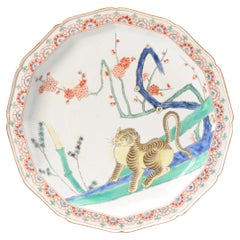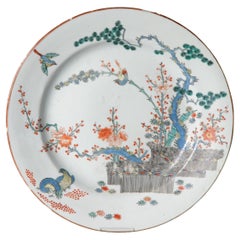Questions & Answers
Our trusted network of 1stDibs sellers answer common questions
What is Japanese pottery called?
1 Answer

Japanese pottery is called tojiki or yakimono. Various types have names of their own. For example, porcelain made during the Edo period is arita-yaki, while blue and white porcelain is seto-mono. On 1stDibs, shop a selection of Japanese pottery on 1stDibs.
1stDibs ExpertApril 5, 2022
Related Questions
- What is Kakiemon style?1 Answer
- What is Hirado porcelain?1 Answer
- What is a porcelain socket?1 Answer
- What is a porcelain sign?1 Answer
- What is a porcelain vase?1 Answer
Shop for Kakiemon Porcelain on 1stDibs
Antique Japanese Kakiemon Porcelain Tiger Plate, Top Quality Work Japan
Located in Amsterdam, Noord Holland
A lovely Kakiemon dish with Tiger
19th Century or earlier.
Condition
Perfect. Size 256 x
Category
Antique 17th Century Japanese Edo Ceramics
Materials
Porcelain
Meissen Chinese Butterfly or Schmetterling Pattern Dinner Service
By Meissen Porcelain
Located in Boston, MA
flowers around the edge are influenced from the Japanese Kakiemon porcelain. There is raised white relief
Category
Vintage 1950s German Chinese Export Porcelain
Materials
Porcelain
High Quality 18 Century Kangxi Period Chinese Porcelain Kakiemon Plate Dutch
Located in Amsterdam, Noord Holland
kakiemon porcelain. The rounded surface of a porcelain bowl lends
itself beautifully to their depiction
Category
Antique 18th Century Chinese Qing Ceramics
Materials
Porcelain
Chocolate Pot, Kakiemon Decoration, Bow Porcelain Factory, circa 1755
By Bow Porcelain
Located in Melbourne, Victoria
decoration after the Kakiemon.
Provenance: Christie’s Melbourne; Taylor Collection.
Category
Antique Mid-18th Century English Japonisme Porcelain
Materials
Porcelain
Soup Tureen, Kakiemon Decoration, Bow Porcelain Factory, circa 1755
By Bow Porcelain
Located in Melbourne, Victoria
Oval tureen and cover, decorated after the Kakiemon in the two quail pattern; the crabstock handles
Category
Antique Mid-18th Century English Japonisme Porcelain
Materials
Porcelain
Baluster Mug, Kakiemon Decoration, Bow Porcelain Factory, circa 1753
By Bow Porcelain
Located in Melbourne, Victoria
. The face of the mug painted after the Kakiemon with the two Quail pattern. The reverse painted with a
Category
Antique Mid-18th Century English Japonisme Porcelain
Materials
Porcelain


